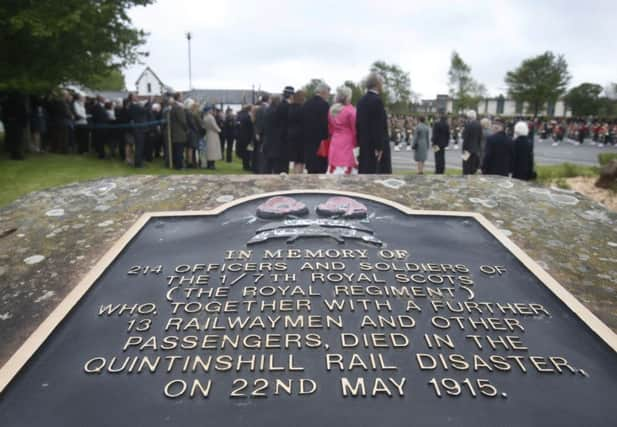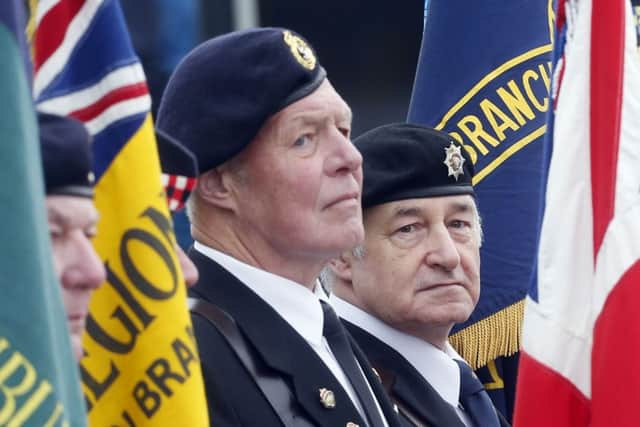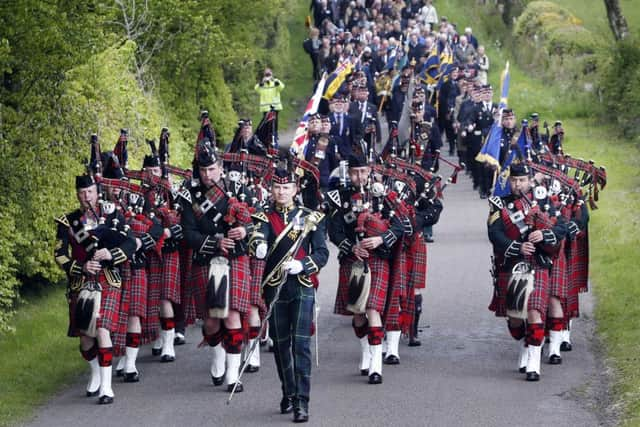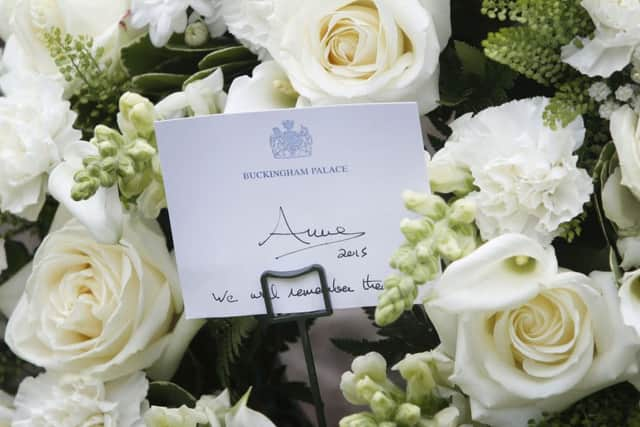Quintinshill rail disaster centenary remembered


The Princess Royal and First Minister Nicola Sturgeon yesterday attended a special service in Gretna on the Scottish-English border on the centenary of the Quintinshill rail crash.
At 6:50am on 22 May 1915, a train packed with First World War troops travelling from Larbert, Stirlingshire, collided with a local passenger service.
Advertisement
Hide AdStraight afterwards, a Glasgow-bound express train smashed into the wreckage at the Quintinshill signal box, setting off a devastating fire which engulfed the troop train, packed with nearly 500 members of the Leith Battalion of the Royal Scots. More than 200 soldiers and 12 civilians were killed and a further 246 people were injured.


The troops were on their way to Liverpool, where they were due to sail to the front line of the war in Gallipoli.
Events in Gretna yesterday included a march to Quintinshill rail siding, the unveiling of a roll of honour at Gretna Old Parish Church and a commemorative tree planting at Gretna Green war memorial.
Princess Anne laid a wreath beside the roll of honour monument, and a second wreath was laid on behalf of the Royal Scots regiment.
She will attend a second service with Ms Sturgeon in Rosebank Cemetery in Edinburgh today, where many of the soldiers were buried in a mass grave.


First Minister Ms Sturgeon said: “The Quintinshill disaster remains the country’s most devastating ever rail crash and the tragic loss of life will never be forgotten.
Advertisement
Hide Ad“Its impact still resonates on the communities of Gretna and Leith a century on and these memorial events are a fitting way to pay tribute to those who died.”
Scottish Secretary David Mundell was also at the service in his Dumfriesshire constituency.
Advertisement
Hide AdHe said: “A century on, the memory of the terrible disaster at Quintinshill still evokes strong emotions in the local community and across Scotland.


“It was a disaster which claimed the lives of young men travelling to join one of the bloodiest battles of the First World War, leaving a huge gulf in Scottish families and communities already affected by that conflict.”
Andrew Rennie, 66, who served with the Royal Scots for six years, said the commemorations were welcomed by servicemen and women as many people today are unaware of the Quintinshill disaster.
Mr Rennie, from Maybole in Ayrshire, said: “It’s because it was the British Rail ‘Titanic’. It was hidden because so many mistakes were made. The signalmen weren’t to blame – they were actually given their jobs back. They were to say that they had done it so that it could all be quietened down.
“It had a lot do with the military as well – they were moving 400 or 500 men and they didn’t want it made public where they were going south and what they were going to do.


“So it all got quietened down and it shouldn’t have been. It takes a parade like this for us to stand here today and bring it to the forefront and let everyone else know that we appreciate what these guys did and where they were going.”
Advertisement
Hide AdWriter Adrian Searle, co-author of The Quintinshill Conspiracy, attended the commemorations for what he described as a “truly terrible” accident.
Mr Searle, 66, from the Isle of Wight, said: “This accident, although it’s the worst ever in the country’s history, it hasn’t been particularly well known.
Advertisement
Hide Ad“The reason for this is that it happened during wartime when necessity dictated that it was, to an extent, covered up or quietened down, if you like.
“It was a truly terrible crash. The words ‘horrific’ and ‘horrendous’ are over-used in the English language but here they are entirely appropriate.
“It was an absolutely shocking disaster.”
Mr Searle added: “The railways were vital to the war economy, to the war effort, and public confidence in the railways had to be maintained.
“Therefore the government did not need too much said about the accident. They needed to keep it as simple as possible, and the simplest way possible was to put it on to the shoulders of two errant, rule-breaking, careless signal men.
“Far too simple an explanation, as far as we were concerned in writing our book. There had to be more to it, and indeed there was a great deal more to it. You could say that a lot more people should have been brought to book over it, other than the two guys who were sent to prison.”